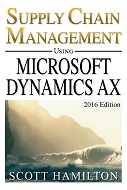Summarizing the SCM changes in Microsoft Dynamics AX 2012 R2
The R2 release for Dynamics AX 2012 included several significant changes in software functionality for supply chain management, especially for the formula approach to product structure. This article summarizes the proportionate magnitude of these R2 changes, and briefly describes the impact of the new capabilities. Subsequent articles will provide more detailed explanations and illustrative case studies to help accelerate the incremental learning of AX professionals. As this series will reveal, the new capabilities broaden the functional footprint of Dynamics AX, allowing customers to replace manual or non-integrated approaches with an integrated solution.
Quantifying the R2 Changes
This article extends a previous analysis about the incremental SCM functionality within AX 2012 in comparison to AX 2009, which was based on my book about Food Products Manufacturing using Microsoft Dynamics AX 2012. The previous analysis employed a heat map (based on page count metrics) to highlight the proportionate magnitude of changes, and this article employs the same metrics for incremental R2 changes. The heat map displayed in Figure 1 summarizes the book's topics, and a bar chart portrayal of previous functionality within AX 2009 (shown in light grey) and the incrementally new functionality within AX 2012 (shown in dark grey) and AX 2012 R2 (shown in black). The entire length of a bar represents a complete walkthrough of the topic using AX 2012 R2, so you get a proportionate magnitude of changes.

Figure 1 Heat Map for Incremental Learning of Dynamics
AX 2012 R2
FREE Membership Required to View Full Content:
Joining MSDynamicsWorld.com gives you free, unlimited access to news, analysis, white papers, case studies, product brochures, and more. You can also receive periodic email newsletters with the latest relevant articles and content updates.
Learn more about us here





